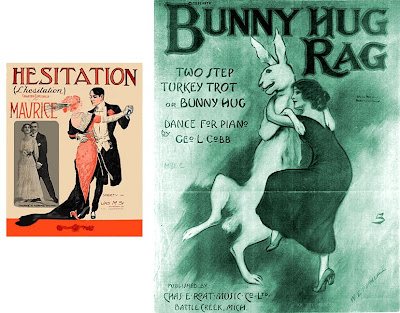

 left, "The Return from Toil," working girls as sketched by John Sloan; right, Variété (English Couple Dancing), 1912/13, Ernst Ludwig Kirchner
left, "The Return from Toil," working girls as sketched by John Sloan; right, Variété (English Couple Dancing), 1912/13, Ernst Ludwig KirchnerA week ago or so at a client meeting I found a book in the "free" pile– Cheap Amusements: Working Women and Leisure in Turn-of-the-Century New York by Kathy Peiss. Published in the 1980s, the book has a very academic and earnest "Women's History" approach which would be enough to turn me off normally, but I particularly got caught up in the chapters on dancing and "Putting on Style."
The first decades of the 20th century brought legions of girls and young women–garment workers, salesgirls, artificial flower makers, tobacco workers– into the work force. Some of these women even lived on their own– a very new phenomenon. The book focuses mostly on working class women who were intrigued by the novel concept of "leisure time", influenced by feminist intimations of the "New Woman" and enticed by a range of modern consumer options.
Most people think of the 1920s as erupting into dance, champagne and louche-ness in a fireworks display of Modernity when in fact, the years leading up to the First World War were rather "fast" and raucous in their own right. Much of the behavior the "Jazz Age" gets credit for had its beginnings before the War.
New York was "dance mad." Social clubs and amusement societies held rackets or blow outs at one of the many dance palaces that would hold up to 3000 patrons. "Rough girls" smoked and teased their hair into high pompadours, augmented with puffs and rats. They wore red high heels and exaggerated straw hats drooping under the weight of stuffed birds, and sprays of artificial flowers. They flocked to dance halls, hotels, restaurants for dancing teas and a chance to learn the One-step, the Gaby Glide, the Hesitation Waltz, the Maxixe, Tango, and the Shimmy.
Some of the dances became huge controversial fads and were banned from respectable establishments. The Grizzly Bear, Bunny Hug and the Turkey Trot in particular were said to have originated about 1906 in the brothels of San Francisco's Barbary Coast and were judged vulgar, bordering on obscene. The very worst of the dances invited "much twirling and twisting and easy familiarity...in nearly all the men in the way they handle the girls," according to an observer. "Once learned the participants can at will instantly decrease or increase the obscenity of the movements."
Many venues instituted patrols to maintain decorum and public declarations were made against the new dances. The New York Times of January 16, 1912 reported an announcement at the Hotel Astor "Should there be any of you who have the inclination to dance the grizzly bear, the turkey trot or an exaggerated form of the Boston dip the members of the Floor Committee will stop you."
Investigators sent to prowl the dance halls by the Committee of Fourteen (whose focus was the suppression of commercialized vice) found patrons "smoking cigarettes, hugging and kissing and running around the room like a mob of lunatics." The girls, they found, were "game and lively and sought out flirtation. They go out for a good time and go the 'Limit'".
* * *
"It was the hesitation drag...and never before has there been such a gliding sliding hesitancy; never before such a dreamy drag; never before such a culminating triumph as the whirl, a la pivot. It was supreme; it was new... It was a dance that renounced halos for high jinks, disapproval for complete surrender."What I enjoy most in reading history is when the accrual of a few small casual details suddenly makes the subject recognizable. In an instant a description of "history" becomes knowable, the facts lift from the page. Despite the fact that we see the 1910s in black and white and consider it part of history, it no more felt like or unfolded like "history" than right now feels to us. History is not a place– it is not bound by "the past"– it's simply a stream of everydays.
Djuna Barnes– Brooklyn Daily Eagle, September 5, 1913
* * *










1 comment:
What an engaging look back at dance!
Brings to mind the old saw: Baptists disapprove of sex because it might lead to dancing...
Post a Comment